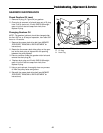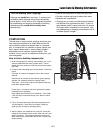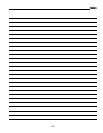
LC-5
Lawn Care & Mowing Information
TIPS On Dealing With Clippings
Clippings are beneficial to your lawn. A common mis-
conception about clippings is that they automatically
lead to thatch—this is untrue. Short clippings produced
by broadcasting and clippings produced by mulching
methods actually contribute to a healthy lawn
because they:
• Reduce the evaporation of water from your lawn.
• Provide a cushioning layer to reduce lawn wear.
• Moderate soil temperature.
• Clippings act as a safe, non-polluting and inexpen-
sive fertilizer that nourishes your lawn. Fresh cut
grass blades are 85% water, and are a rich source
of nitrogen which is essential to lush growth. And
one garbage bag of clippings contains about 1/4 lb.
of usable organic nitrogen.
COMPOSTING
The best way to recycle excess clippings and leave your
lawn looking immaculate is to collect them with an effi-
cient collection system and deposit them in a compost
pile. A compost pile is a collection of grass, leaves, and
other organic wastes which—when properly tended—
decompose into an odorless, topsoil material. This
material, in turn, acts as an inexpensive fertilizer for your
lawn and garden.
How to start a healthy compost pile:
1 Build a bin using bricks, fencing, cement blocks, etc. or pur-
chase a prefabricated bin from a garden store. The bin
should also have venting on each side and from the bottom
to the top.
2 Fill the bin with alternating layers of yard waste. Follow this
recipe:
First layer: 3-4 inches of chopped brush or other coarse
material.
Second layer: 6-8 inches of mixed leaves, grass clippings,
sawdust, etc. Materials should be "sponge damp."
Third layer: 1 inch of soil to add micro-organisms that help
break down organic matter.
Fourth layer: 1-2 inches of manure to provide the nitrogen
needed by micro-organisms.
Keep adding layers until the bin is almost full. Top off with
a 4-6 inch layer of straw and scoop out a "basin" to catch
rain water.
3 Four or five days later the pile will reach temperatures of
140-160 degrees. At this time you'll notice it settling, a
good sign your compost is working properly.
4 After 5-6 weeks, fork materials into a new pile, turning the
outside of the old heap into the center of the new one. Add
water if necessary. The compost should be ready to use
within three to four months when dark brown, crumbly, and
earthy-smelling.


















